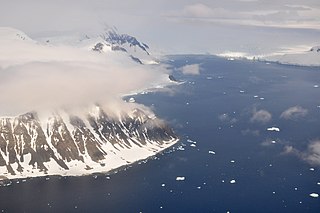
The International Polar Years (IPY) are collaborative, international efforts with intensive research focus on the polar regions. Karl Weyprecht, an Austro-Hungarian naval officer, motivated the endeavor in 1875, but died before it first occurred in 1882–1883. Fifty years later (1932–1933) a second IPY took place. The International Geophysical Year was inspired by the IPY and was organized 75 years after the first IPY (1957–58). The fourth, and most recent, IPY covered two full annual cycles from March 2007 to March 2009.

Albert Paddock Crary, was a pioneer polar geophysicist and glaciologist. He was the first person to have set foot on both the North and South Poles, having made it to the North Pole on May 3, 1952 and then to the South Pole on February 12, 1961, as the leader of a team of eight. The South Pole expedition set out from McMurdo Station on December 10, 1960, using three Snowcats with trailers. Crary was the seventh expedition leader to arrive at the South Pole by surface transportation. He was widely admired for his intellect, wit, skills and as a great administrator for polar research expeditions.

Edward Adrian Wilson was an English polar explorer, ornithologist, natural historian, physician and artist.

The Scott Polar Research Institute (SPRI) is a centre for research into the polar regions and glaciology worldwide. It is a sub-department of the Department of Geography in the University of Cambridge, located on Lensfield Road in the south of Cambridge.
Beau Riffenburgh is an author and historian specializing in polar exploration. He is also an American football coach and author of books on football history.

Frank Debenham, OBE was Emeritus Professor of Geography at the Department of Geography, Cambridge University and first director of the Scott Polar Research Institute.

Sir James Mann WordieCBE FRS FRSGS LLD was a Scottish polar explorer and geologist. Friends knew him as Jock Wordie.

John Riddoch Rymill was an Australian polar explorer, who had the rare second clasp added to his Polar Medal.
Robert Neal Rudmose-Brown was a Scottish academic botanist and polar explorer.
Huw Lewis-Jones is a British historian, editor, broadcaster and art director. Formerly a historian and Curator of Art at the Scott Polar Research Institute, University of Cambridge, Lewis-Jones left Cambridge in June 2010 to pursue book and broadcasting projects. He is the Editorial Director of the independent publishing company Polarworld.
Arctic is a quarterly, peer-reviewed, multidisciplinary, scientific journal, published by the Arctic Institute of North America. The focus of Arctic is original research articles on all topics about or related to the northern polar and sub-polar regions of the world. Additional published formats are book reviews, profiles of notable persons, specific geographic locations, notable northern events, commentaries, letters to the editor, and a general interest section consisting of essays and institute news. Mutltidisciplinary coverage encompasses physical sciences, social sciences, biological sciences, humanities, engineering, and technology. The journal was first published in spring of 1948.

Bernard Stonehouse was a British scientist who specialised in animal behaviour, polar research and popular science. In 1953 he received the Polar Medal.

Polar Geography is a quarterly peer-reviewed academic journal covering research on the physical and human aspects of the Polar regions of Earth. It is published by Taylor & Francis and was established in 1977. From 1980 to 1994 it was known as Polar Geography and Geology.
Alfred Stephenson OBE was an English polar explorer and surveyor.
Stig Valter Schytt was a Swedish glaciologist.
Terence Edward Armstrong was a British polar geographer, sea ice specialist, writer, and expert on the Russian Arctic.

Polar Science is a quarterly peer-reviewed scientific journal covering research related to the polar regions of the Earth and other planets. It is published by Elsevier on behalf of the National Institute of Polar Research (Japan). It covers a wide range of fields, including atmospheric science, oceanography, glaciology and environmental science. The editor-in-chief is Takashi Yamanouchi.

Surgeon Captain Edward W. Bingham, was a British Royal Navy officer and polar explorer who had the rare third clasp added to his Polar Medal.
Ann Margaret Savours Shirley was a British historian of polar exploration, covering both the Arctic and Antarctic. She was most widely known for her study of Robert Falcon Scott's ship HMS Discovery.
The South Polar Times was a magazine created by the crew of the two Antarctic voyages led by Captain Robert Falcon Scott in the early 20th century: the Discovery Expedition (1901–04), and the Terra Nova Expedition (1910–13). It documents first-hand many professional and personal aspects of Antarctic exploration, and highlights some of the physical and psychological hardships the men suffered. It was established in part to entertain the crew, all of whom were offered the opportunity to contribute. The magazine combines watercolour paintings, cartoons, and photographs with weather reports, essays, and other colloquial and scientific observations.












